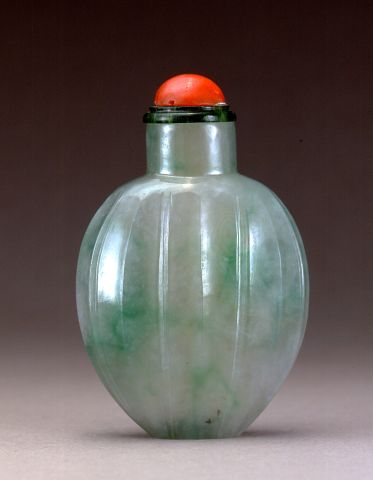
Bottle ID: 429
GREEN, CREAMY WITH VERTICAL RIBS
Date: 1820-1860
Height: 58 mm
Jadeite, very well hollowed, of translucent green tone with icy white mottling, carved with accentuated vertical concave ribbing suggesting a fruit form, the foot slightly concave and with shoulders sloping towards a slightly concave mouth.
Similar Examples:
Crane Collection no. 301 and no. 714.
Sotheby's, London, March 3, 1987, lot 131, The Collection of Eric Young, Part I.
Stevens, Bob C. The Collector's Book of Snuff Bottles, 1976, pp. 112-113, no. 357.
Provenance:
Robert Hall
Alan Wheatley, UK
Robert Hall
Dinah O'Brien, U.S.A.
Jadeite has been classified by the Chinese by a scientific system, known as Jian ting, "the verification of authenticity". In this system it can be measured for different characteristics which combine to give the overall quality of a piece. These characteristics are as follows:
Texture (zhong) is a measure of the differences in the crystalline body structure and is shown in two ways; firstly, through water content, and secondly, through ground. This reveals both translucency and the size of the crystals within the material.
Color, (se), to the Chinese is one of the most important measures of the value of a piece. However, a deep color with a rough texture is obviously not as valued as a translucent and deep color. Of the many shades of color, green, in certain forms, is the most rare and valuable. Madam Ou Yang in her book, 'Appreciating Jadeite' separates color into four elements: saturation, brilliance, evenness and purity.
She concludes that only by the inclusion of these features can a piece of jadeite be considered to approach perfection. This is without even the consideration of texture which we have previously mentioned. Saturation refers to the depth of colour or darkness of the stone. Brilliance is harder to explain, but more easily understood as it refers to the "glow" in the stone. That this is important is reflected in the name feicui, the second part referring to brilliance. Evenness is the requirement that colour is spread evenly through the stone, unless artistry dictates otherwise. The fourth ideal is purity which dictates that a colour has no secondary hue. Impure tones affect saturation, brilliance and evenness, making the jadeite less attractive to the eye.
These four characteristics relating to colour combine with the two features relating to texture, provide the essential elements for judging jadeite. However, there are no clear divisible lines between more or less evenness, more or less purity or more or less translucency and as such any judgment becomes as subjective as the metaphorical judgments of "moss in snow" or "plantain shoots after rain". Beyond a judgment of the material relating to the tenets outlined above, it is perhaps best to leave the basic languages of visual art behind and simply enjoy the stone.
< Back to full list

 English
English 中文
中文